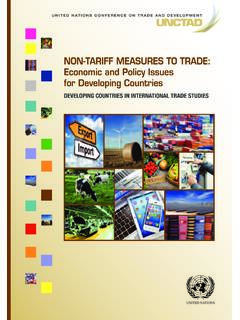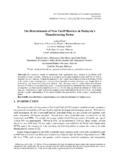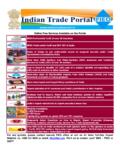Transcription of OECD Trade Policy Working Paper No. 45 THE …
1 Organisation for Economic Co-operation and Development 2006 Organisation de Coop ration et de D veloppement Economiques OECD Trade Policy Working Paper No. 45 THE ROLE OF Trade barriers IN SME INTERNATIONALISATION By Barbara Fliess and Carlos Busquets ABSTRACT This Paper discusses Trade barriers that SMEs are likely to encounter in export markets and available Policy tools aimed at their reduction or elimination. Drawing on recent work in the Trade Directorate and elsewhere, key types of barriers are identified based on a review of business surveys and other studies recently undertaken. The Paper also explores how governments deal with Trade barriers and how SME participation in the Trade Policy process can be facilitated. As far as barriers in export markets are concerned, firms, large and small, continue to face import tariffs.
2 Non-tariff barriers matter equally, if not more, with customs procedures and domestic regulations emerging as widely noted impediments to Trade and less direct and visible procedural barriers also playing a role. Due to their size SMEs are in a vulnerable position in relation to Trade barrier impact. Overcoming Trade barriers requires significant investment both in time and resources, which can constrain SME participation in the Trade Policy process. National experiences with consultation schemes and other support programmes that help exporting SMEs diagnose Trade barriers or present the opportunity to raise issues, related to Trade barriers , directly with policymakers suggest ways for enhancing SME participation in the Policy process. Business and Trade associations also can give voice to SME interests with governments at home and abroad.
3 This Paper offers recommendations on how governments can take SME concerns better into account and support the internationalisation of their business activities. Keywords: Small and Medium-sized Enterprises (SMEs), Trade barriers , non-tariff barriers (NTBs), tariffs, business surveys, exports, export markets, OECD, non-OECD, Trade Policy , negotiations, consultations, Trade advocacy, Trade associations. ACKNOWLEDGEMENTS The Paper was co-authored by Barbara Fliess, Senior Analyst in the OECD Trade Directorate, and Carlos Busquets, Consultant. An earlier version was presented at the Workshop on External barriers to Internationalisation of the OECD/APEC Global Conference on Removing barriers to SME Access to International Markets taking place on 6-8 November 2006 in Athens, Greece.
4 The Paper was one of many contributions solicited by the OECD Centre for Entrepreneurship, SMEs and Local Development, responsible for organising the Athens conference. The Paper has drawn on work prepared under the OECD Trade Directorate programme of work on non-tariff barriers to Trade in goods; however, the analysis and opinions expressed are those of the authors and do not necessarily represent the views of the OECD or its Members. Copyright OECD 2006 Application for permission to reproduce or translate all or part of this material should be made to: OECD Publications, 2 rue Andr Pascal, 75775 Paris Cedex 16, France. 2 TABLE OF CONTENTS Executive 3 A. Introduction .. 4 B. Trade barriers faced by SMEs: more evidence .. 5 I. What types of barriers have SMEs encountered?.. 5 1. Import tariffs still matter to exporting, in many sectors and 6 2.
5 NTBs matter equally if not more than import tariffs, with customs procedures and domestic regulation being widely noted 3. Less direct and visible procedural barriers can, by themselves, influence market access significantly .. 8 II. Heightened vulnerability of SMEs to Trade C. Options for addressing Trade barriers .. 11 I. How can home governments address barriers in export markets?.. 11 II. How can SMEs influence the Trade Policy process? .. 11 1. Public consultation process .. 13 2. Programmes to assist SMEs overcome Trade 14 D. Conclusions .. 16 Annex 1. Concerns about Trade barriers reported in business 18 Boxes Box 1. Certification requirements in EU market perceived to be costly or 8 Box 2. Procedural barriers to Trade reported in business surveys .. 9 Box 3. National experiences with consultative mechanisms.
6 14 Box 4. Select support programmes .. 15 3 EXECUTIVE SUMMARY SMEs are a major source of job creation and economic growth but tend to be underrepresented in their share of international Trade flows relative to their contribution to national and regional economies. Building on the results of the OECD/APEC Paper on Removing barriers to SME Access to International Markets and drawing on work that the Trade Directorate has undertaken, this Paper provides a deeper analysis of the Trade barriers faced by SMEs in foreign markets. It reviews other existing business surveys and studies for more detailed information about Trade barriers . The Paper also explores how governments deal with Trade barriers and how SMEs participation in the Trade Policy process can be facilitated. Many business surveys on Trade barriers draw attention to the fact that tariffs continue to cause problems for companies, large and small, that wish to access foreign markets.
7 They also indicate that non-tariff barriers matter equally, if not more, with customs procedures and domestic regulations emerging as widely noted impediments. Furthermore less direct and visible procedural barriers can, by themselves, influence market access significantly. Because of their size, SMEs are in a vulnerable position in relation to Trade barriers , which discourages internationalisation. Overcoming Trade barriers requires significant investment in both time and resources. As a result, an SME may be unable or unwilling to fully engage and take advantage of available government consultation mechanisms and strategies for dealing with barriers in foreign markets, such as engaging trading partners in negotiations, launching legal proceedings or pursuing Trade advocacy. Active SME participation can be enhanced in several ways.
8 Some government have created programmes that actively assist firms, both large and small, in overcoming Trade barriers and SME interests also can be given voice by business and/or Trade associations. Ways forward should include continued Trade negotiations as well as regulatory co-operation among governments to reduce compliance costs. In addition, SMEs would benefit from open, balanced, and transparent government-business consultations as part of the Trade Policy process. 4 THE ROLE OF Trade barriers IN SME INTERNATIONALISATION* A. Introduction 1. In line with other trends of globalisation, Small and Medium-sized Enterprises (SMEs) are increasingly involved in international business. They not only account for a significant share of exports but also import and link up to global production networks.
9 2. As they attempt to internationalise, SME often encounter substantial barriers . These barriers are complex and can be both internal to a particular firm or emanating from the larger business environment in which SMEs operate, including Trade Policy barriers . 3. Jointly with APEC, OECD has studied and explored ways of Removing barriers to SME Access to International Markets . The aim of this project, whose findings and Policy recommendations were presented at a conference in Athens, Greece on 6-8 November 2006, is to gain better understanding of the barriers to internationalisation1 faced by SMEs, and to share knowledge of government programmes aimed at addressing barriers and helping SMEs to access international markets. The data on barriers to access to international markets were collected by means of two surveys that asked economic policymakers and SMEs, respectively, for their perceptions.
10 Policymakers furthermore were asked to provide information on existing support programmes. 4. One key finding of this project is that a majority of SMEs surveyed rated barriers related to internal capabilities and access as being the most significant towards internationalisation and those related to business environment (including Trade Policy ) as being of lesser importance. However, a shift in perception occurs when SME responses are broken down according to their level of activity in international markets. Non-active exporters tended to be mostly concerned with financial and access barriers whereas firms with export experience had increased concerns regarding their operating business 5. Building on the results of the Perceptions of SME Survey (please see Annex 13 of Removing barriers to SME Access to International Markets ) and drawing on work that the Trade Directorate has undertaken, in recent years, this Paper provides a deeper analysis of Trade Policy related barriers faced by SMEs in foreign markets.
















